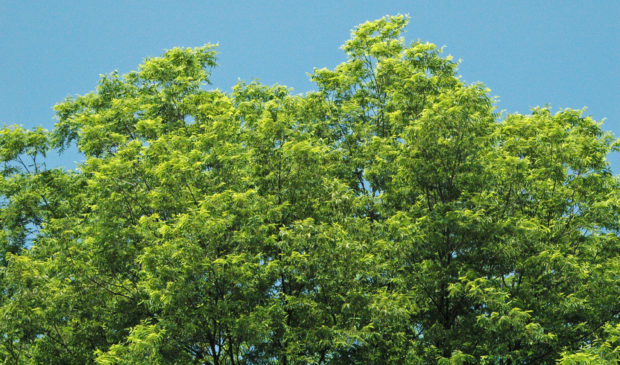Tree protection outweighs density concerns for Environmental Commission
Friday, April 19, 2019 by
Jessi Devenyns There are only four reasons a heritage tree can be removed in the city of Austin: it must be dead, diseased, an imminent hazard, or prevent reasonable use of a property.
Even if a tree meets one or more of these criteria, it is often with a heavy heart that the city allows for its removal. At the April 17 meeting of the Environmental Commission, despite the city arborist’s recommendation to save one of the two heritage pecan trees at 2111 Rio Grande St., commissioners tried to deny the developers the two variance requests that would allow for their removal.
While the commissioners couldn’t save both trees, they did vote 8-1 to save the 37-inch-diameter pecan tree on the edge of the property. The vote also aligned the commission with staff’s determination that the developers could remove the 34-inch-diameter pecan.
Both the developer’s arborist and Community Tree Preservation Division Manager Keith Mars held the opinion that the smaller of the two heritage trees was diseased and could be removed.
Mars explained that the 34-inch pecan had “large cavities” in its trunk and that furthermore, “the tree prevents a reasonable use of the property.” Given that it meets half of the requirements laid out in the Heritage Tree Ordinance for removal, he did not stand in the way of its uprooting.
The larger pecan tree, however, caused a bit of contention. “The applicant’s position is that the tree is an imminent hazard,” Mars told the commission. “We disagreed.”
Dan Hayden of Davey Tree, whose team analyzed the condition of the pecan, came to explain their findings to the commission. He said, “It had some basal decay, which is pretty common,” but that overall, the tree “showed pretty sound wood.” The problem, he explained, is that the tree is already in a state of stress response and would likely not survive the planned two-and-a-half-year construction of a 690-bedroom high-rise and a four-level, below-ground garage.
Still, he said, as it stands, the tree is alive and not a hazard or in imminent danger of death.
“The tree is fine, and you are going to build something there that would jeopardize it and that’s what we’re trying to avoid,” Commissioner Pam Thompson pointed out.
Several of the commissioners brought the developer’s attention to the fact that slight modifications to the current site plan could move the construction out of the tree’s half critical root zone and negate the need for a variance. City code requires that at least half of a tree’s critical root zone remain undisturbed. Staffers said that they had not seen any alternative design plans, but noted that since the development in question falls within the University Neighborhood Overlay, there are no floor area ratio limitations. The floor area ratio dictates the amount of livable space that can be constructed on a parcel in relation to the lot size. Currently, the only site limitation is caused by the historic inn on the property that will be preserved.
Chair Linda Guerrero pointed out that the pecan, while scraggly, was a sturdy specimen that had already survived the nearly incessant construction in the area.
While staff supported cutting down the 34-inch pecan, Guerrero expressed her concern with the removal of the trees and the lack of green infrastructure and mitigation in the area to replace the lost greenery. Due to the condition of the tree, staff originally recommended a reduced mitigation rate of 150 percent or 51 inches of mitigation. Commissioners, however, felt strongly about keeping as much vegetation as possible in the area. “I don’t think there should be a reduction in the mitigation requirement’s full 300 percent mitigation for the 34-inch (tree),” said Commissioner Katie Coyne.
In addition to requiring the full amount of mitigation for the removal of the 34-inch pecan tree, commissioners also recommended that the project developers relocate a non-protected, 16.5-inch red oak to a site location that will be determined by a city arborist.
“The Heritage Tree Ordinance is not the Pretty Heritage Tree Ordinance,” Commissioner Peggy Maceo reminded everyone.
Commissioner Curtis Smith was absent from the meeting.
Photo by James St. John made available through a Creative Commons license.
The Austin Monitor’s work is made possible by donations from the community. Though our reporting covers donors from time to time, we are careful to keep business and editorial efforts separate while maintaining transparency. A complete list of donors is available here, and our code of ethics is explained here.
You're a community leader
And we’re honored you look to us for serious, in-depth news. You know a strong community needs local and dedicated watchdog reporting. We’re here for you and that won’t change. Now will you take the powerful next step and support our nonprofit news organization?











